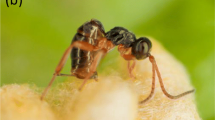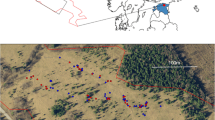Abstract
The pronotum is the most distinctive and representative structure in treehoppers. Although several functions have been proposed for this structure, its involvement in fitness has not been formally evaluated. Given the high degree of maternal investment exhibited by the subsocial membracid Alchisme grossa (Hoplophorionini), the pronotum has been suggested as a shield for offspring protection. We performed selection gradient analyses on A. grossa in order to evaluate how natural selection is acting upon two traits associated with this structure considering three different fitness proxies: (1) number of eggs, (2) the ratio between the number of first-stage nymphs and the number of eggs (early survival), and (3) the number of third-stage nymphs (late survival). Since A. grossa feeds, oviposits and mates on two alternative host-plants (Brugmansia suaveolens and Solanum ursinum, both Solanaceae), we also evaluated and compared selection gradients between these host-plants. We found positive linear selection acting upon pronotum length considering the number of eggs and the late survival fitness proxies and positive linear selection acting on the distance between the suprahumeral horns considering the early survival proxy on females ovipositing on both host-plants. These results highlight the importance of the pronotum in treehoppers females’ fitness and suggest that maternal care appears to have a greater importance in the way that natural selection is operating than the host-plant where oviposition occurs.


Similar content being viewed by others
References
Arnold SJ (1983) Morphology, performance and fitness. Am Zool 23:347–361
Boulard M (1983) Sur deux Anchistrotus et la mutilation naturelle du pronotum chez les Membracides de ce genre. Bull Soc Entomol Fr 88:274–283
Bristow CM (1983) Treehoppers transfer maternal care to ants: a new benefit of mutualism. Science 220:532–533
Camacho L, Keil C, Dangles O (2014) Factors influencing egg parasitism in sub-social insects: insights from the treehopper Alchisme grossa (Hemiptera, Auchenorrhyncha, Membracidae). Ecol Entomol 39(1):58–65
Caruso CM, Peterson SB, Ridley CE (2003) Natural selection on floral traits of Lobelia (Lobelliaceae): spatial and temporal variation. Am J Bot 90(9):1333–1340
Choe JC, Crespi BJ (1997) The evolution of social behavior in insects and arachnids. Cambridge University Press, Cambridge
Cocroft RB (1996) Insect vibrational defense signals. Nature 382:679–680
Cocroft RB (1999a) Offspring-parent communication in a subsocial treehopper (Hemiptera: Membracidae: Umbonia crassicornis). Behaviour 136(1):1–21
Cocroft RB (1999b) Parent-offspring communication in response to predators in a subsocial treehopper (Hemiptera: Membracidae: Umbonia crassicornis). Ethology 105:553–568
Cocroft RB (2002) Antipredator defense as a limited resource: unequal predation risk in broods of an insect with maternal care. Behav Ecol 13(1):125–133
Cocroft RB, Rodríguez RL, Hunt RE (2008) Host shifts, the evolution of communication and speciation in the Enchenopa binotata species complex of treehoppers. In: Tilmon KJ (ed) Speciation, specialization and radiation: the evolutionary biology of insect and plant interactions. University of California Press, California, pp 88–100
Cocroft RB, Rodríguez RL, Hunt RE (2010) Host shifts and signal divergence: mating signals covary with host plant use in a complex of specialized plant-feeding insects. Biol J Linn Soc 99:60–72
Creão-Duarte AJ, Sakakibara AM (1997) Revisao de Alchisme Kirkaldy (Hemiptera, Membracidae, Membracinae, Hoplophorionini). Rev Bras Zool 14(2):425–472
Cuartas-Domínguez M, Medel R (2010) Pollinator-mediated selection and experimental manipulation of the flower phenotype in Chloraea bletioides (Orchidaceae). Funct Ecol 24:1219–1227
Del-Claro K, Oliveira PS (1996) Honeydew flicking by treehoppers provides cues to potential tending ants. Anim Behav 51:1071–1075
Del-Claro K, Oliveira PS (1999) Ant-Homoptera interactions in a Neotropical savanna: the honeydew-producing treehopper, Guayaquila xiphias (Membracidae), and its associated ant fauna on Didymopanax vinosum (Araliaceae). Biotropica 31(1):135–144
Flores-Prado L, Pinto CF, Rojas A, Fontúrbel FE (2014) Strong selection on mandible and nest features in a carpenter bee that nests in two sympatric host plants. Ecol Evol 4(10):1820–1827
Godoy C, Miranda X, Nishida K (2006) Treehoppers of Tropical America. Instituto Nacional de Biodiversidad, San José
Hodgins KA, Barrett SCH (2008) Natural selection on floral traits through male and female function in wild populations of the heterostylous daffodil Narcissus triandrus. Evolution 62(7):1751–1763
Honek A (1993) Intraspecific variation in body size and fecundity in insects: a general relationship. Oikos 66(3):483–492
Jordano P (1995) Frugivore-mediated selection on fruit and seed size: birds and St. Lucie’s cherry, Prunus mahaleb. Ecology 76(8):2627–2639
Keese MC, Wood TK (1991) Host-plant mediated geographic variation in the life history of Platycottis vittata (Homoptera: Membracidae). Ecol Entomol 16:63–72
Kingsolver JG, Huey RB (2008) Size, temperature, and fitness: three rules. Evol Ecol Res 10:251–268
Kingsolver JG, Pfennig DW (2004) Individual-level selection as a cause of Cope’s rule of phyletic size increase. Evolution 58(7):1608–1612
Kudo S (2002) Phenotypic selection and function of reproductive behavior in the subsocial bug Elasmucha putoni (Heteroptera: Acanthosomatidae). Behav Ecol 13(6):742–749
Lande R, Arnold SJ (1983) The measurement of selection on correlated characters. Evolution 37(6):1210–1226
Lin CP (2006) Social behaviour and life history of membracine treehoppers. J Nat Hist 40(32):1887–1907
Lin CP (2007) Observations of a subsocial treehopper, Stalotypa fairmairii from Cuba (Hemiptera: Membracidae). Fla Entomol 90(2):398–400
Lin CP, Danforth BN, Wood TK (2004) Molecular phylogenetics and evolution of maternal care in membracine treehoppers. Syst Biol 53(3):400–421
McKamey SH, Deitz LL (1996) Generic revision of the New World tribe Hoplophorionini (Hemiptera: Membracidae: Membracinae). Syst Entomol 21:295–342
Medel R (2000) Assessment of parasite-mediated selection in a host-parasite system in plants. Ecology 81(6):1554–1564
Murúa M, Espinoza C, Bustamante R, Marín VH, Medel R (2010) Does human-induced hábitat transformation modify pollinator-mediated selection? A case study in Viola portalesia (Violaceae). Oecologia 163:153–162
Nault LR, Wood TK, Goff AM (1974) Treehopper (Membracidae) alarm pheromones. Nature 249:387–388
Poulton EB (1903) Suggestions as to the meaning of the shapes and colours of the Membracidae, in the struggle for existence. In: Buckton GB (ed) A monograph of the Membracidae. Lovell Reeve, London, pp 273–285
R Core Team (2014) R: A language and environment for statistical computing. R Foundation for Statistical Computing, Vienna, Austria www.R-project.org
Ramaswamy K, Cocroft RB (2009) Collective signals in treehoppers provide predator location cues to the defending mother. Anim Behav 78:697–704
Ruiz-Montoya L, Núñez-Farfán J (2009) Natural selection and maternal effects in life history traits of Brevicoryne brassicae (Homoptera: Aphididae) on two sympatric closely related hosts. Fla Entomol 92(4):635–644
Stegmann UE (1998) An exaggerated trait in insects: the prothoracic skeleton of Stictocephala bisonia (Homoptera: Membracidae). J Morphol 238:157–178
Tallamy DW, Wood TK (1986) Convergence patterns in subsocial insects. Annu Rev Entomol 31:369–390
Torrico-Bazoberry D (2014) Selección natural en el membrácido subsocial Alchisme grossa (Hemiptera: Membracidae) en el contexto de uso de plantas hospederas alternativas. B.Sc. thesis, Universidad Mayor de San Simón, Cochabamba, Bolivia
Torrico-Bazoberry D, Caceres-Sanchez L, Saavedra-Ulloa D, Flores-Prado L, Niemeyer H, Pinto CF (2014) Biology and ecology of the treehopper Alchisme grossa in a cloud forest of the Bolivian Yungas. J Insect Sci 14(169):1–4
Trumbo ST (2012) Patterns of parental care in invertebrates. In: Royle NJ, Smiseth PT, Kölliker M (eds) The evolution of parental care. Oxford University Press, Oxford, pp 81–100
Visser ME (1994) The importance of being large: the relationship between size and fitness in females of the parasitoid Aphaereta minuta (Hymenoptera: Braconidae). J Anim Ecol 63:963–978
Wade MJ, Kalisz S (1990) The causes of natural selection. Evolution 44(8):1947–1955
Weber A, Kolb A (2013) Population size, pollination and phenotypic trait selection in Phyteuma spicatum. Acta Oecol 47:46–51
Wood TK (1974) Aggregation behavior of Umbonia crassicornis (Homoptera: Membracidae). Can Entomol 106:169–173
Wood TK (1975) Studies on the function of the Membracid pronotum (Homoptera) II: histology. Proc Entomol Soc Wash 77(1):78–82
Wood TK (1976) Biology and presocial behavior of Platycotis vittata (Homoptera: Membracidae). Ann Entomol Soc Am 69:807–811
Wood TK (1977) Defense in Umbonia crassicornis: role of pronotum and adult aggregations (Homoptera: Membracidae). Ann Entomol Soc Am 70:524–528
Wood TK (1984) Life history patterns of tropical membracids (Homoptera: Membracidae). Sociobiology 8:299–344
Wood TK (1993) Diversity in the new world Membracidae. Ann Rev Entomol 38:409–435
Wood TK, Morris GK (1974) Studies on the function of the membracid pronotum (Homoptera) I: occurrence and distribution of articulated hairs. Can Entomol 106(2):143–148
Wood TK, Tilmon KJ, Shantz AB, Harris CK, Pesek J (1999) The role of host-plant fidelity in initiating insect race formation. Evol Ecol Res 1:317–332
Acknowledgments
Liliana Caceres and Alejandro Coca provided field support. Comments of Mariano Ordano, Santiago Benitez and two anonymous reviewers improved an earlier version of the manuscript. LANBIO (Latin American Network for Research on Bioactive Natural Compounds) and International Foundation for Science (IFS), who supported and funded this work, and INTEGRA S.A. authorized the work at Incachaca and provided housing facilities.
Author information
Authors and Affiliations
Corresponding author
Ethics declarations
Conflict of interest
The authors declare that they have no conflict of interest.
Additional information
Handling Editor: Heikki Hokkanen.
Rights and permissions
About this article
Cite this article
Torrico-Bazoberry, D., Pinto, C.F., Flores-Prado, L. et al. Natural selection in the tropical treehopper Alchisme grossa (Hemiptera: Membracidae) on two sympatric host-plants. Arthropod-Plant Interactions 10, 229–235 (2016). https://doi.org/10.1007/s11829-016-9427-y
Received:
Accepted:
Published:
Issue Date:
DOI: https://doi.org/10.1007/s11829-016-9427-y




